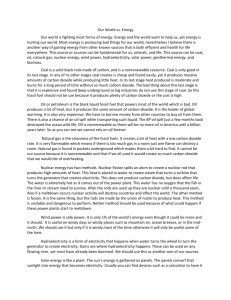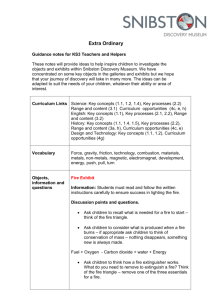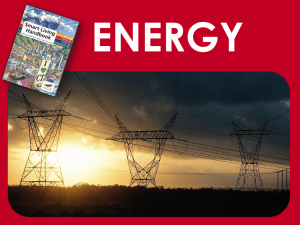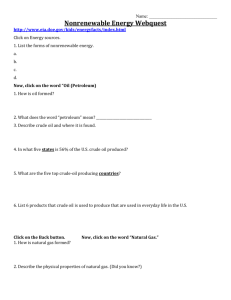wind energy - Cloudfront.net
advertisement
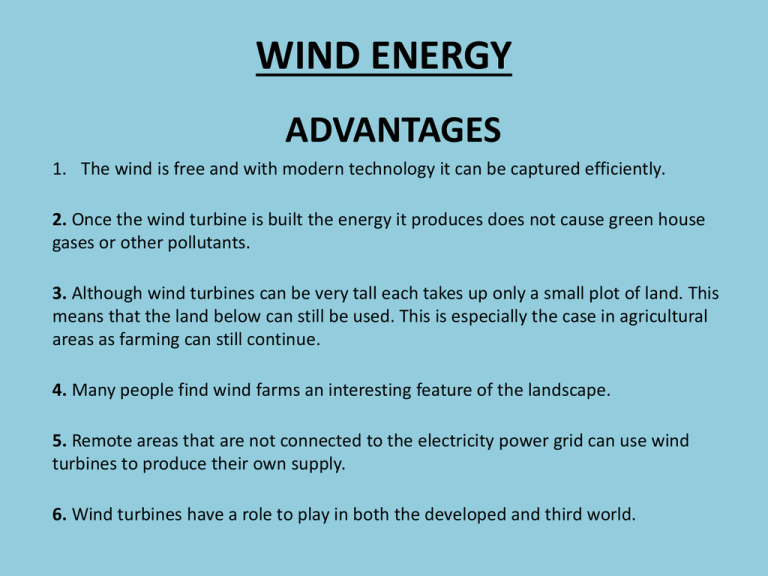
WIND ENERGY ADVANTAGES 1. The wind is free and with modern technology it can be captured efficiently. 2. Once the wind turbine is built the energy it produces does not cause green house gases or other pollutants. 3. Although wind turbines can be very tall each takes up only a small plot of land. This means that the land below can still be used. This is especially the case in agricultural areas as farming can still continue. 4. Many people find wind farms an interesting feature of the landscape. 5. Remote areas that are not connected to the electricity power grid can use wind turbines to produce their own supply. 6. Wind turbines have a role to play in both the developed and third world. WIND ENERGY DISADVANTAGES 1. The strength of the wind is not constant and it varies from zero to storm force. This means that wind turbines do not produce the same amount of electricity all the time. There will be times when they produce no electricity at all. 2. Many people feel that the countryside should be left untouched, without these large structures being built. The landscape should left in its natural form for everyone to enjoy. 3. Wind turbines are noisy. Each one can generate the same level of noise as a family car travelling at 70 mph. 4. Many people see large wind turbines as unsightly structures and not pleasant or interesting to look at. They disfigure the countryside and are generally ugly. 5. When wind turbines are being manufactured some pollution is produced. Therefore wind power does produce some pollution. 6. Large wind farms are needed to provide entire communities with enough electricity. SOLAR ENERGY ADVANTAGES 1. Solar energy is free although there is a cost in the building of ‘collectors’ and other equipment required to convert solar energy into electricity or hot water. 2. Solar energy does not cause pollution. However, solar collectors and other associated equipment / machines are manufactured in factories that in turn cause some pollution. 3. Solar energy can be used in remote areas where it is too expensive to extend the electricity power grid. 4. Many everyday items such as calculators and other low power consuming devices can be powered by solar energy effectively. 5. It is estimated that the worlds oil reserves will last for 30 to 40 years. On the other hand, solar energy is infinite (forever). SOLAR ENERGY DISADVANTAGES 1. Solar energy can only be utilized when it is daytime and sunny. 2. Solar collectors, panels and cells are relatively expensive to manufacture although prices are falling rapidly. 3. Solar power stations can be built but they do not match the power output of similar sized conventional power stations. They are also very expensive. 4. In countries such as the UK, the unreliable climate means that solar energy is also unreliable as a source of energy. Cloudy skies reduce its effectiveness. 5. Large areas of land are required to capture the suns energy. Collectors are usually arranged together especially when electricity is to be produced and used in the same location. 6. Solar power is used to charge batteries so that solar powered devices can be used at night. However, the batteries are large and heavy and need storage space. They also need replacing from time to time. HYDROPOWER ENERGY ADVANTAGES 1. Once a dam is constructed, electricity can be produced at a constant rate. 2. If electricity is not needed, the sluice gates can be shut, stopping electricity generation. The water can be saved for use another time when electricity demand is high. 3. Dams are designed to last many decades and so can contribute to the generation of electricity for many years / decades. 4. The lake that forms behind the dam can be used for water sports and leisure / pleasure activities. Often large dams become tourist attractions in their own right. 5. The lake's water can be used for irrigation purposes. 6. The build up of water in the lake means that energy can be stored until needed, when the water is released to produce electricity. 7. When in use, electricity produced by dam systems do not produce green house gases. They do not pollute the atmosphere. HYDROPOWER ENERGY DISADVANTAGES 1. Dams are extremely expensive to build and must be built to a very high standard. 2. The high cost of dam construction means that they must operate for many decades to become profitable. 3. The flooding of large areas of land means that the natural environment is destroyed. 4. People living in villages and towns that are in the valley to be flooded, must move out. This means that they lose their farms and businesses. In some countries, people are forcibly removed so that hydro-power schemes can go ahead. HYDROPOWER ENERGY DISADVANTAGES 5. The building of large dams can cause serious geological damage. For example, the building of the Hoover Dam in the USA triggered a number of earth quakes and has depressed the earth’s surface at its location. 6. Although modern planning and design of dams is good, in the past old dams have been known to be breached (the dam gives under the weight of water in the lake). This has led to deaths and flooding. 7. Dams built blocking the progress of a river in one country usually means that the water supply from the same river in the following country is out of their control. This can lead to serious problems between neighboring countries. 8. Building a large dam alters the natural water table level. For example, the building of the Aswan Dam in Egypt has altered the level of the water table. This is slowly leading to damage of many of its ancient monuments as salts and destructive minerals are deposited in the stone work from ‘rising damp’ caused by the changing water table level. GEOTHERMAL GEOTHERMAL ADVANTAGES 1. Geothermal energy is relatively environmentally friendly. Pollution in the form of fumes are not produced although usually drilling of the earths surface takes place. The surrounding environment is not harmed with the exception of the land required for the power plant and transport links. 2. Unlike wind power, geothermal power can be relied on as it provides constant power. 3. The use of conventional polluting fuels such as oil and coal can be reduced if geothermal and other alternative energy forms are used (reducing pollution). 4. Geothermal power can take different forms. For instance, it can be used to produce electricity or the hot water can be used directly to heat homes and businesses. GEOTHERMAL DISADVANTAGES 1. Not Widespread Source of Energy : Since this type of energy is not widely used therefore the unavailability of equipment, staff, infrastructure, and training pose hindrance to the installation of geothermal plants across the globe. 2. High Installation Costs : To get geothermal energy, requires installation of power plants, to get steam from deep within the earth and this require huge one time investment and require to hire a certified installer and skilled staff needs to be recruited and relocated to plant location. 3. Can Run Out Of Steam : Geothermal sites can run out of steam over a period of time due to drop in temperature or if too much water is injected to cool the rocks and this may result huge loss for the companies which have invested heavily in these plants. Due to this factor, companies have to do extensive initial research before setting up the plant. 4. Suited To Particular Region : It is only suitable for regions which have hot rocks below the earth and can produce steam over a long period of time. Some of these regions are near hilly areas or high up in mountains. 5. May Release Harmful Gases : Geothermal sites may contain some poisonous gases and they can escape deep within the earth, through the holes drilled by the constructors. 6. Transportation : Geothermal Energy can not be easily transported. Once the tapped energy is extracted, it can be only used in the surrounding areas. BIOMASS ADVANTAGES 1. No Harmful Emissions : Biomass energy, for the most part, creates no harmful carbon dioxide emissions. (Pollutions) 2. Clean Energy : Because of its relatively clean use, biomass energy, when used in commercial businesses such as airlines, receives tax credit from the US government. This is good for the environment and good for business. It does release carbon dioxide but captures carbon dioxide for its own growth. Carbon dioxide released by fossil fuel are released into the atmosphere and are harmful to the environment. 3. Abundant and Renewable : Biomass products are abundant and renewable. Since they come from living sources, and life is cyclical, these products potentially never run out, so long as there is something living on earth and there is someone there to turn that living things components and waste products into energy. 4. Reduce Dependency on Fossil Fuels : It has developed as an alternate source of fuel for many homeowners and have helped them to reduce their dependency on fossil fuels. 5. Reduce Landfills : Another benefit of this energy is that it can take waste that is harmful to the environment and turn it into something useful. 6. Can be Used to Create Different Products : Biomass energy is also versatile, as different forms of organic matter can be used to create different products. Ethanol and similar fuels can be made from corn and other crops. With so many living things on the planet, there is no limit to how many ways it can be found and used. BIOMASS DISADVANTAGES 1. Expensive : Firstly, its expensive. Living things are expensive to care for, feed, and house, and all of that has to be considered when trying to use waste products from animals for fuel. 2. Inefficient as Compared to Fossil Fuels : Secondly, and connected to the first, is the relative inefficiency of biomass energy. Ethanol, as a biodiesel is terribly inefficient when compared to gasoline, and it often has to be mixed with some gasoline to make it work properly anyway. 3. Harmful to Environment : Thirdly, using animal and human waste to power engines may save on carbon dioxide emissions, but it increases methane gases, which are also harmful to the Earth’s— ozone layer. So really, we are no better off environmentally for using one or the other. And speaking of using waste products, there is the smell to consider. While it is not physically harmful, it is definitely unpleasant, and it can attract unwanted pests (rats, flies) and spread bacteria and infection. 4. Consume More Fuel : Finally, using trees and tree products to power machines is inefficient as well. Not only does it take a lot more fuel to do the same job as using conventional fuels, but it also creates environmental problems of its own. 5. Require More Land : Combustion of biomass products require some land where they can easily be burnt. Since, it produces gases like methane in atmosphere; therefore it can be produced in those areas which are quite far from residential homes. NUCLEAR ENERGY ADVANTAGES 1. Reliability - Nuclear Power is a highly reliable form of energy almost as good as other fossil fuel energy forms like coal, gas etc.. 2. Produces Large Amount of Energy Nuclear reactions release a million times more energy, as compared to hydro or wind energy. 3. No Air Pollution – Nuclear electricity does not cause air pollution. 4. Low Fuel Cost - Large amounts of Nuclear Energy can be produced from the fission on radioactive elements like uranium. The costs of nuclear fuel is very low compared to other energy sources like coal and gas. 5. Low Electricity Cost – The cost to produce electricity from Nuclear Power is quite low . Nuclear Plants also have long lives of between 40-60 years which means that they are extremely profitable once constructed within reasonable costs. NUCLEAR ENERGY DISADVANTAGES 1. Radiation Accidental release of harmful radiation is one of the biggest drawbacks of nuclear energy. If safety measures fail, the radiation may come in contact with the environment, resulting in severe damage to the ecosystem and loss of life. 2. Nonrenewable Although they produce large amount of energy, nuclear reactors depend on uranium, which is an exhaustible fuel. 3. Huge Building Cost Though large amount of energy can be produced from a nuclear power plant, it requires large capital cost. 4. Nuclear Waste The waste produced after fission reactions contains unstable elements, and is highly radioactive. It is very dangerous to the environment as well as human health, and remains so for hundreds of years. 5. Transport of Fuel and Waste Transport of uranium fuel and the radioactive waste is very difficult. Uranium emits some amount of radiation, and hence, needs to be handled with care. Secondly, the nuclear waste produced is more hazardous and needs extra protection. COAL ADVANTAGES 1. Coal energy is an affordable energy source because of the coal’s stable price compared to other fuel sources. 2. Coal is easy to burn. 3. Coal produces high energy upon combustion. 4. Coal energy is inexpensive. 5. Coal is abundant. 6. Coal energy is a reliable energy source. COAL DISADVANTAGES 1. Coal energy produces large amount of carbon dioxide which leads to global warming and climate change. 2. Burning of coal is not environmental friendly because it produces harmful byproducts and gas emissions such as sulfur dioxide, carbon dioxide and nitrogen oxide that causes pollution to the environment including acid rain. 3. 4. Coal energy is nonrenewable energy source. Coal is fast depleting because we consume too much of it. 5. Coal mining ruins the environment and puts the lives of people specially the coal miners in danger. PETROLEUM ADVANTAGES 1. Oil is one of the most abundant energy resources. 2. Liquid form of oil makes it easy to transport and use. 3. Oil has high heating value. 4. Relatively inexpensive. 5. No new technology needed to use. PETROLEUM DISADVANTAGES 1. Oil burning leads to carbon emissions (pollution). 2. Oil recovery processes not efficient enough—technology needs to be developed to help gather larger quantities at a time. 3. Oil drilling endangers the environment and ecosystems. 4. Oil transportation (by ship) can lead to spills, causing environmental and ecological damage. 5. Fossil fuels such as petroleum (oil) take millions of years to form. NATURAL GAS ADVANTAGES 1. Burns clean compared to, oil (less polluting) 2. 70% less carbon dioxide compared to other fossil fuels. 3. Does not produce ashes after energy release. 4. Inexpensive compared to coal and oil. 5. No odor until gas companies add chemical. The added chemical is a safety measure companies add so people can smell the gas, in case a gas leak occurs. 6. Its efficiency is highly regarded where it could outlast both oil and coal since it isn't exactly the most popular energy source yet. NATURAL GAS DISADVANTAGES 1. Because it is a non renewable source of energy, its availability is limited. 2. Extraction leaves large craters within the earth. 3. Highly volatile (highly flammable), and can be dangerous if handled carelessly. In gas pipelines, a substance (contains carbon monoxide) that has a strong odor is added to help detect a leak. But such substances may be harmful and cause deaths if not carefully handled. In fact, natural gas is the most common cause of carbon monoxide deaths. 4. Constructing and managing transportation pipelines costs a lot if not the transporting of the substance itself. 5. While it may give off lesser carbon dioxide than other sources of energy, it is nonetheless damaging the ecosystem. 6. It isn't used in vehicles as a primary source of fuel since it is a highly combustible substance.



